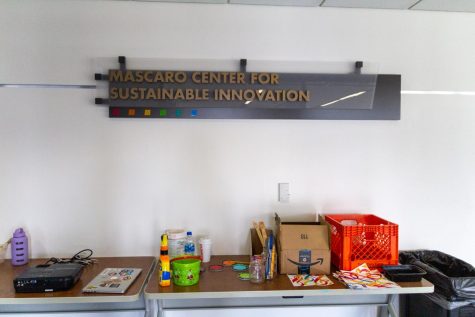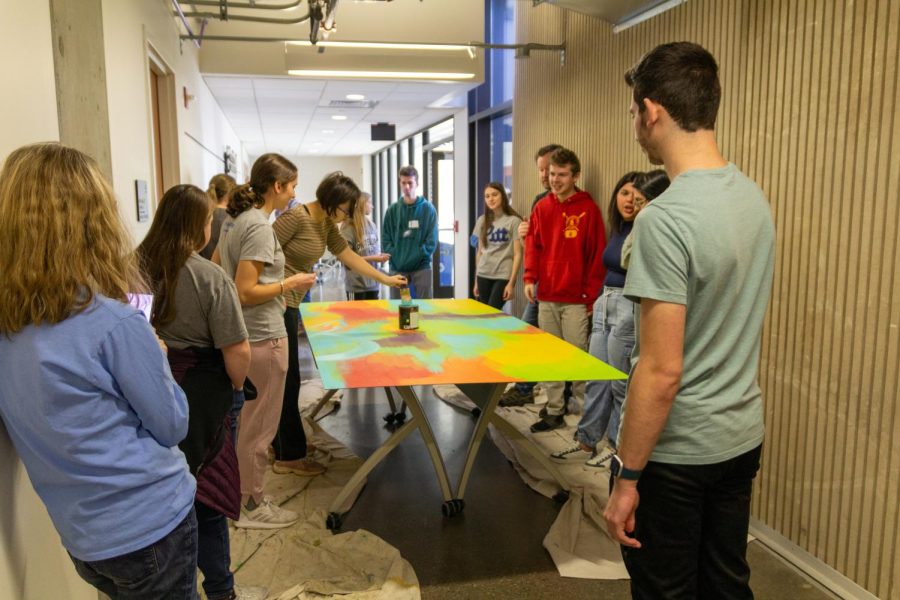SNAP collaborates with Pittsburgh Center for Arts and Media for neurodiversity mural
John Blair | Senior Staff Photographer
Students participate in painting the SNAP mural on Sunday.
January 29, 2023
Vivid swirls of red, orange, purple, yellow and blue paint filled two panels in Benedum Hall this Sunday, forming interlocked infinity symbols that hover over a rainbow background.
Painted by members of the Special Needs Assistance Program for Social Engagement, these colors and designs will gradually come together over two weeks to create a mural celebrating neurodiversity. SNAP members split into groups to work on two separate panels that will form an 8-by-8-foot mural. The final product will hang on the first floor of Benedum Hall, and SNAP is planning an unveiling ceremony in late February to honor the work put into the mural.
SNAP is a student organization at Pitt with a mission to educate and inform the neurotypical population about neurodiversity. Zachary Miller, a sophomore bioengineering student and SNAP President, said one of the organization’s goals is to bridge neurodiverse and neurotypical communities.
“One of the main focuses of SNAP is to make a platform that allows for the equal communication between the two communities,” Miller said. “Neurodiverse people can come out, get to do some really cool stuff, and everyone’s on an equal playing field.”
SNAP collaborated with the Pittsburgh Center for Arts and Media, a local nonprofit, to plan and design the mural. The first painting sessions took place this past weekend in Benedum Hall, and participants will complete the mural in the final two sessions next weekend.
Collaborating with resident artist Alison Zapata, who has worked on large murals in the South Side and Squirrel Hill, SNAP conceptualized the mural to answer the question, “What inspires and uplifts you?” Zapata said she always works with groups to consider everyone’s ideas in the creation of the mural.
“We came together and had a number of discussions to enable participants to have both a voice and choice in the design,” Zapata said. “All the murals I do I try to give the people that are working on it a chance to get their ideas in there and have their voice in the artwork.”
During the last session, participants focused on completing the design. Next weekend, the club will add positive affirmations within the mural’s infinity signs using paint markers.
Ashley Sabia, SNAP’s business manager and public relations officer, said one of the best parts of the mural is the surprise of watching it evolve day by day.
“It’s so much fun just to be here with everyone, and I feel like the entire time the mural and the finished product was kept very quiet, so this is very much a surprise for us to see how it’s evolving and being painted,” Sabia said.

(John Blair | Senior Staff Photographer)
Maria Palmer, a photographer and attendee at the event, said until she discovered many famous artists who were also on the autism spectrum, she was afraid to tell others that she is neurodiverse.
“I was ashamed years ago of revealing I had autism,” Palmer said, “until I researched some celebrities and historians like Michelangelo, Mozart, Hans Christian Andersen, Emily Dickinson, Tim Burton, so many people 一 it’s because of them that I don’t feel ashamed.”
Palmer said she would like to see more community engagement with neurodiverse individuals like herself who aren’t Pitt students.
“I think we need an open poetry night where people will read poetry and honor Emily Dickinson, that’d be a great thing to relate to the autism spectrum,” Palmer said. “I think SNAP should incorporate not just students at Pitt, but anybody in Allegheny County, more often.”
This mural event is one of SNAP’s community events that engage both Pitt students and people from the surrounding area. Inspired by his two siblings with autism, Miller said he founded SNAP in May 2022 to create a method and space for neurodiverse and neurotypical individuals to communicate.
“I wanted to help them, in all of its simplicity,” Miller said. “They are medium support, and they can convey their needs, but they struggle to convey their thoughts, so I really wanted a way that I can more easily communicate with them and be on their level.”
Along with club events like mural painting, SNAP also hosts speaker events and works on research to create a tool that easily facilitates neurodiverse and neurotypical communication. Miller’s research goal is to find a way for more understanding of slang language between groups.
“It’s an AI-based communication tool that will take some time to listen to your conversations, to interpret the language and the different pragmatics that each person uses, and then be able to be used as a translator app,” Miller said.
While she’s not actively working on research like Miller, Zapata’s experience as an artist has shown her a tool for bringing groups together and increasing communication between people — muralism.
“I really enjoy watching people come together, who might not have known each other, to create something that’s never existed before,” Zapata said. “Mural painting has a very powerful transformative quality to it, that pupils don’t focus on the self, they focus on something bigger.”



